| 1 | The longest rattlesnake species |
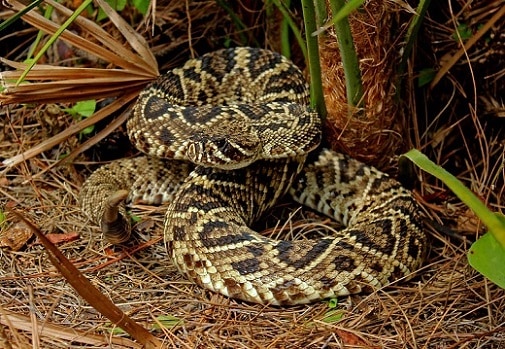
The eastern diamondback rattlesnake is a species of the US southeast, and is most concentrated in Florida, Georgia and Alabama. They mainly live in dry woodlands and pine-oak forests, hiding in comfortable gopher tortoise holes and moving around slowly. The claim to fame of this rattlesnake is being the longest and heaviest of all living species. Not just of the 15-20 species living in the US, but the 25-30 living in Mexico and further afield. There are rattlesnakes on stormy mountaintops and scorching Mexican deserts with nothing but cacti in sight, but the longest rattlesnake of all lives in a simple Floridian woodland which yellow schoolbuses drive past every day, barely any distance from civilisation.
Eastern diamond rattlesnakes begin life at 30cm, at a weight of 35-48.5 grams. After 3 years, the average female measures 100cm, while males are slightly longer at 125cm. From then on, they grow more slowly, yet continuously for the rest of their lives. The longest officially documented Crotalus adamanteus measured 244cm (shot in 1946), but this hasn’t stopped absurd rumours from appearing, including a 4.5 metre brute captured near St Augustine in 2009.
| 2 | Brutally long fangs |
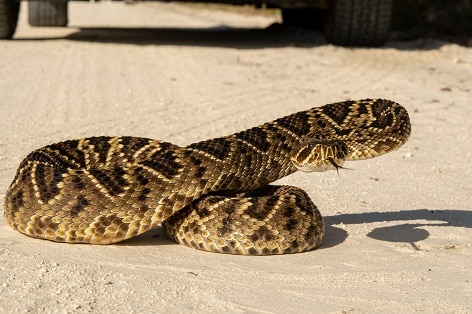
Anyone unlucky enough to meet an eastern diamondback rattlesnake can tell that they’re built like a tank. They hold a second rattlesnake record – the heaviest, at an average adult weight of 2-10 pounds. The heaviest one ever weighed 34 pounds. While eastern diamondbacks aren’t the longest US snake (a record held by the coachwhip), they are the heaviest, thanks to their thick, stubby body.
A third, more terrifying record relates to fangs. Specifically, Crotalus adamanteus has the longest fangs relative to size of any rattlesnake. These brutal venom syringes measure 1.7 inches in a 150cm rattler, and are estimated to reach 2.5cm in a 2.4 metre rattler.
Then there’s the tidalwave of venom they effortlessly produce, which you guessed it, is the highest out of all 50+ rattlesnake species. Crotalus adamanteus produces 400-450mg in a single bite. If you’re very lucky, they’ll produce just 200mg (still above the upper record of an eastern coral snake). If you’re terribly unlucky then they’ll produce a flood of 1000mg, which is the current record for an eastern diamondback bite.
| 3 | Lurks in vacant tortoise burrows |
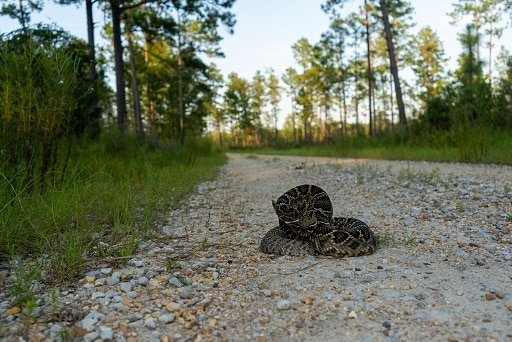
Eastern diamondbacks are never found on a busy street. They’re rarely found in pasture land and they’re never found in the densest, darkest forests. Instead, they’re a species of open canopy woodlands such as pine-oak, palmetto flatwoods and sandhills. Their favourite of all is longleaf pines, where they love to hide in gopher tortoise burrows, as well as burrows of the nine-banded armadillo. Eastern diamondbacks spend much time in these dark holes, enjoying the cool and shelter, and each diamondback has its own personal base to live in. This is mainly a ground snake. Climbing trees is extremely rare, yet when the urge strikes, they still possess the necessary skills, as one was recorded 10 metres above ground on a branch.
Likewise, they’re surprisingly strong swimmers, and have been found many miles off shore from Florida Keys islands, floating casually. Eastern diamondbacks are sometimes spotted on beaches next to their clumps of woodlands.
Historically, eastern diamondbacks resided in 7 states: Louisiana, North and South Carolina, Florida, Georgia, Alabama and Mississippi. Crotalus adamanteus has no overlap with its cousin the western diamondback, which only strays into extreme west Virginia.
| 4 | Grim statistics |
If you’re in the Florida everglades, look down, and see an eastern diamondback hanging off your arm, then survival is likely, as antivenom is stocked in every major hospital. But if you somehow don’t make it (maybe bumping into an alligator gang on the way home), then the chance of death is 10-20%, with some estimating 40%.
Eastern diamondbacks have virtually no neurotoxins at their disposal. Unlike the Mojave rattlesnake, they never cause full body paralysis, respiratory failure, slurred speech, or blurred vision, the classic neurotoxic symptoms. Instead, this is a venom that unleashes utter tissue chaos. The venom causes immense swelling, widespread necrosis, and agonising pain due to a release of bradykinin. There’s also hypotension, and discolouration of the affected limb.
Eastern diamondback venom specialises in haemolysis, the rupturing of red blood cells. Some of the symptoms are brutal, such as bleeding from the mouth, and an intense internal pain. Amputation is a possibility, as shown by the case of a Korean woman who was bitten on the finger in a reptile enclosure, and later had the tip amputated.
| 5 | Destructive, corrosive venom |
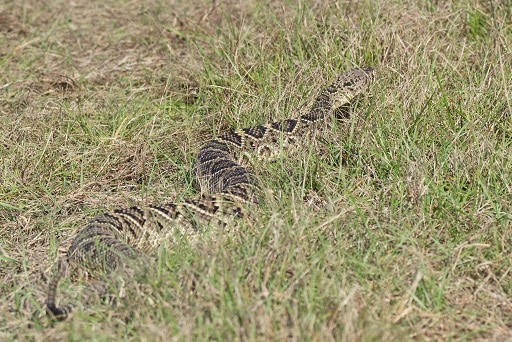
The most abundant ingredient in eastern diamondback venom is crotamine, a myotoxin which targets and degrades muscle tissue. In mice, this is powerful enough to cause complete paralysis. In humans, a milder version appears, as a signature Crotalus adamanteus symptom is muscle spasms and twitching, but there’s also reports of leg paralysis. In neurotoxic snakes, this is because of brain signals being disrupted, but in eastern diamondbacks, this is because of sheer muscle fibre destruction.
The second most abundant toxin class is the L-amino-acid oxidases. These are responsible for the local skin chaos, particularly swelling and the apoptosis of healthy cells. Eastern diamondback venom has a yellow colour, and the LAAOs are why. There’s also the metalloproteases, which unleash widespread physical damage, cleaving through peptide bonds in the amino acids making up protein structures.
With a tsunami of venom, the only saving grace is that the LD50 rating isn’t extraordinarily high, at 1.2mg. This is higher than a cottonmouth (2mg), but lower than a tiger rattlesnake (0.06mg) or green mamba (0.24mg).
| 6 | Wildly variable venom |
One fascinating fact about eastern diamondback rattlesnakes is that a bite may be different everywhere you go. 65 members were analysed in a 2015 study, from various locations across Florida. The northern populations had far more myotoxins, the toxins which directly assault muscle fibres. These were lessened in the southern enclaves, and on Cadalesi Island off Florida’s west coast, the myotoxins were missing completely. Meanwhile, the northern populations had lower quantities of metalloproteases and L-amino oxidase, responsible for the swelling and skin tissue destruction.
Another interesting study went deep into prehistory. It found that a rattlesnake ancestor lived 12-14 million years ago, and had 7 genes responsible for a host of toxins from neurotoxins to hemotoxins and myotoxins. Yet in the modern day eastern diamondback, the genes for neurotoxins were completely deleted, which took place an estimated 6 million years ago. Similarly, the Mojave rattlesnake lost its genes for myotoxins an estimated 4 million years ago. It’s rare for genes to be deleted entirely, as even humans have remnants of genes for extraordinarily powerful smell like in bears. Today, the Mojave and eastern diamondbacks have just 2 of the original 7 toxins genes in common.
| 7 | One of the loudest rattles |
Crotalus adamanteus is something of an uber-rattlesnake and that advancedness extends to the rattle itself. It consists of 7-10 segmented scales, and can be heard from particularly far away. This is the opposite of the pygmy rattlesnake, which has the quietest rattle, sounding more like a buzzing fly.
Crotalus adamanteus begins life at a level 1 rattle: a single segmented scale that resembles a button. With each skin shed, they gain a new rattle scale, and the first shed takes place 10-20 days after birth, thus ascending to a level 2 rattle. They shed 3-4 times in their first year, so it doesn’t take long for Crotalus adamanteus to become a fully bloomed, woodland-stalking, rattling menace.
Like all pitvipers, eastern diamondback rattlesnakes have hinged fangs which easily fold back into their mouths (solenoglyphous fangs). They also have sharply vertical pupils, another pitviper staple. The final pitviper feature is heat-sensing pits in their head which allow them to detect slight temperature variations in prey against the ambient air, granting them infrared night vision.
| 8 | Vicious brute or gentle giant? |

One of the great debates about eastern diamondbacks centres around their personality. Theory one is that they’re irritable serpents with a mean streak, which won’t let any interlopers come near. Tales abound of them rattling aggressively from even nine metres away.
Theory two, which seems more likely, is that eastern diamondbacks are surprisingly docile and prefer to rely on their stupendous camouflage for survival. For example, this author (who began studying the species in 1976) purposefully stepped on an eastern diamondback in a pine forest. This elicited zero reaction. To his horror, he then realised that his other foot was standing on a second, hidden eastern diamondback, which was so well camouflaged it was invisible. Yet neither diamondback bothered to react.
There’s also great superstitions, passed down from grandmother to grandchild, one being that eastern diamondbacks must rattle before striking. In reality, they’re perfectly capable of lying motionless in the undergrowth, and striking at legs without the usual nervous buzz.
| 9 | Cares for its babies (possibly) |
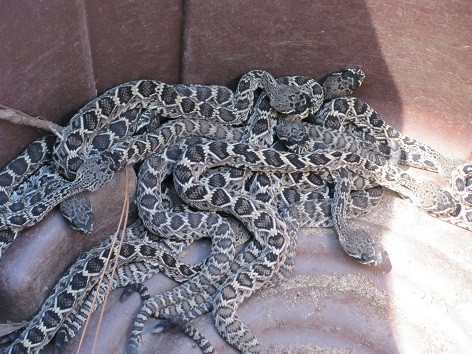
The east and western diamondbacks still fight a grisly contest to have the highest death toll. Eastern dimaondbacks are commonly cited as the top killer, but even experts can’t agree. Both live alongside other rattlesnakes, smudging the statistics, causing some deaths to be reported as solely “rattlesnake”. The most recent confirmed case happened in 2005, when 54 year old Joe Guidry shot at a rattlesnake which had bothered his neighbour in Putnam County, Florida. It retreated under his shed, and when he reached in to grab the diamondback, he was bitten on the arm.
Eastern diamondbacks have a particularly long gestation period, at 120-180 days. As ever, males seek out females using their advanced scent apparatus. Once mating is done, the male will slither away instantly and not return. Mothers are too scared to give birth in the open, and usually seek a nice, cosy hole. This can be a hollow log, but their favourite is a vacant gopher tortoise (Gopherus polyphemus) burrow.
Finally, the mother will lay an average of 14 live rattlers, rather than eggs. Newborns are capable of eating a fully grown mouse from day 1. Mothers stay with the babies for 10-20 days, showing an unusually caring personality for a snake. But there’s an alternative theory as well: that mothers are so exhausted after giving birth that they slump over and can’t move.
| 10 | The rare patternless morph |
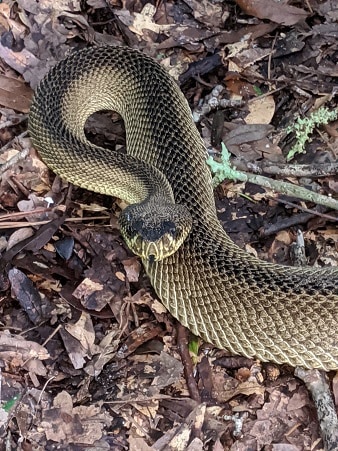
In 2020, one of the weirdest things was discovered in northern Florida: a Crotalus admanteus with no patterns. It was discovered by Pierson Hill, working on behalf of the Florida Fish and Wildlife Conservation Commission (FWC). It possessed the typical olive-black colouring, with hints of yellow, but in a smooth style instead.
“This color morph is exceptionally rare—only a small handful of patternless diamondbacks have been documented by biologists,” posted the FWC on their facebook page. It was believed to be a genetic feature, passed on by recessive alleles in the mothers and fathers. Hill fitted the patternless diamondback with a microchip to allow future tracking.
Another cool observation happened on September 9th 2015, when scientists discovered a litter of 15 east diamondbacks on Jekyll Island, Georgia, One snake measured 37.4cm and weighed 42.8 grams, and was implanted with a radio tracker. 1 year later, the scientists followed their signal and rediscovered the snake. It now measured 95cm, and weighed 700 grams, a mass gain of 1536% in a year. According to the scientists, “To our knowledge, this is the fastest growth rate reported for C. adamanteus“. Weirdly, it was just 0.5 metres away from its mother.
